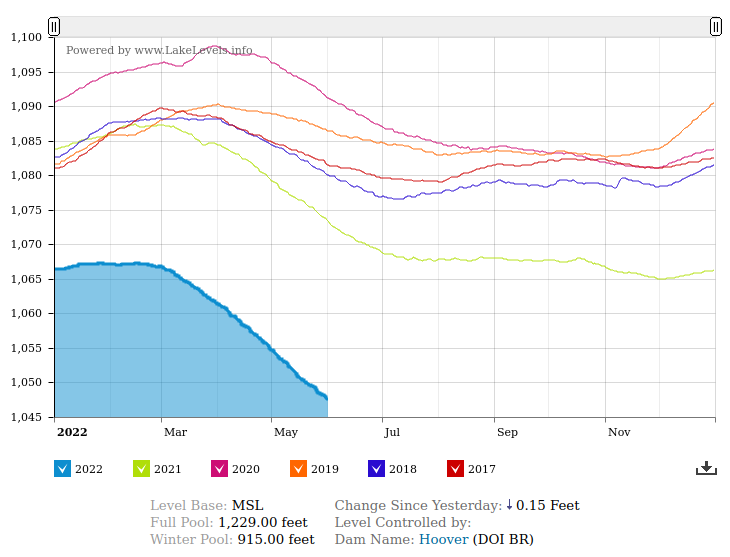

And developers are building huge new housing developments outside St. George and the illegals keep pouring in.
The idiot left has been whining about Lake Mead/Hoover Dam and Lake Powell/Glen Canyon dam forever. Well, their wish has finally come true. Now they can stop all their whining.
Lake Mud
I can’t believe I just read an article about Lake Mead that didn’t work in climate change propaganda. Maybe, just maybe, larger populations living in desert areas plays some kind of role.
Iron rule of civilization.
One cannot develop beyond the capacity of the land to support it.
Nevada and Arizona are about to experience “sticker shock”
If the enviro-whackos would quit prioritizing fish over people, we could store the water rather than let it flow to the ocean.
Under the Colorado River Compact of 1922 (an interstate agreement ratified by Congress), and the Boulder Canyon Project Act of 1928, California is entitled to 4.4 million acre-feet of water per year from the Colorado River.
What does this mean? Arizona and Nevada have to release enough water downstream so that the greater Los Angeles fantasyland can fill its swimming pools and water their lawns via aqueducts and pipelines.
Mother Nature is draining Lake Mead because she knows where the bodies are buried:
Bodies found in drought-depleted Lake Mead could be linked to gangsters, say mob experts
And yet, I and many others have a lawn here in Scottsdale/ Phoenix. Yesterday the city went into a level 1 water warning. Means nothing... “Try to conserve” No penalties or rules.
Side note - The doomsday nature of this article misses the fact that Arizona uses 36% of the Lake Mead allocation. It’s not 100% dependent on the Colorado. For me- getting rid of my lawn will probably halve my water usage. That, and convincing my daughters to limit their showers to 30 minutes instead of an hour.
In other words, we’ll survive. They will not allow Hoover to become a dead pool before sending out police to ticket water abusers. There’s tons of room to reduce usage. That said, I’m not one for mandates, but this finite resource should have some strings attached.
Thanks for the graph, kinda disputes this line from the story: “Lake Mead is now way below 1,050 ft. in elevation”
Part of the problem is that for the last two years, the winter snowfall has been near-normal, but in the spring the air mass over the snowpack has been warm and dry (a lot of fire-weather warnings) and most of the snow has evaporated/sublimated and blown away rather than melting and flowing into the rivers.

The lower it gets, the faster it drops.
There’s plenty of fresh water in the world, we should’ve built the Grand Canal project decades ago and channeled the fresh water down from the Hudson’s Bay region. That would provide a flow of fresh water down to the lower 48 twice the size of Niagra Falls. Of course the Enviro Wackos succeeded in blocking the project.
Forgive my ignorance:
Is the larger problem w/ Meade and more draw or less intake?
Obviously, it’s both, but I’m curious as to which is the larger cause here for Meade and Lake Powell.
Following.
The natural-color images above were acquired on July 6, 2000, and July 3, 2022, by Landsat 7 and Landsat 8. The detailed images below also include a view from Landsat 8 on July 8, 2021 (middle). The light-colored fringes along the shorelines in 2021 and 2022 are mineralized areas of the lakeshore that were formerly underwater when the reservoir was filled closer to capacity.
https://earthobservatory.nasa.gov/images/150111/lake-mead-keeps-dropping
Continuing a 22-year downward trend, water levels in Lake Mead stand at their lowest since April 1937, when the reservoir was still being filled for the first time. As of July 18, 2022, Lake Mead was filled to just 27 percent of capacity.
The largest reservoir in the United States supplies water to millions of people across seven states, tribal lands, and northern Mexico. It now also provides a stark illustration of climate change and a long-term drought that may be the worst in the U.S. West in 12 centuries.
The low water level comes at time when 74 percent of nine Western states face some level of drought; 35 percent of the area is in extreme or exceptional drought. In Colorado, location of the headwaters of the Colorado River, 83 percent of the state is now in drought, and the snowpack from last winter was below average in many places.